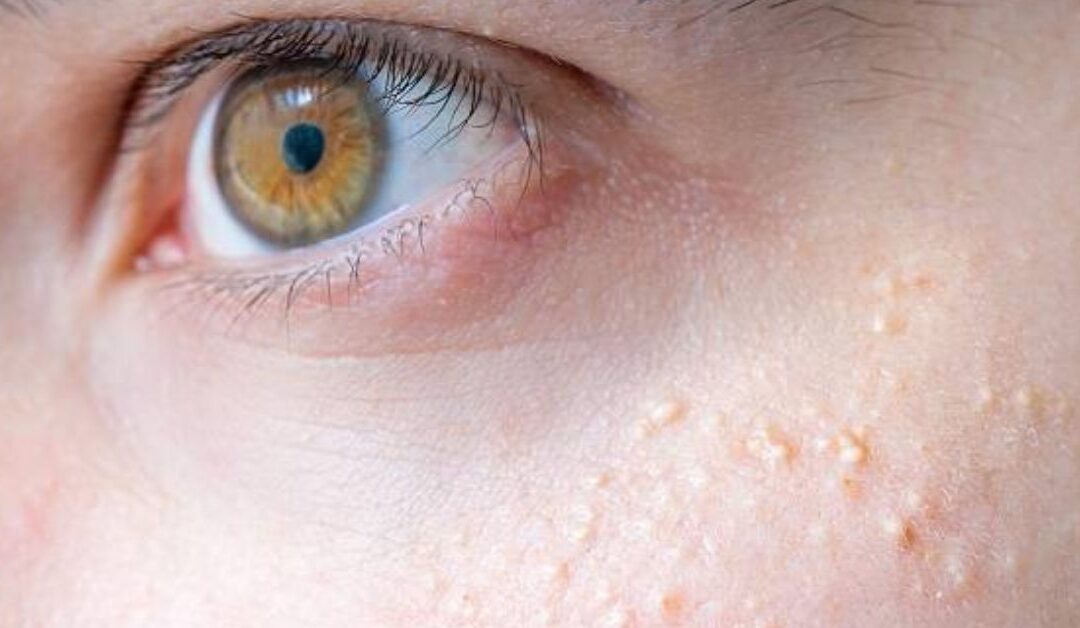It doesn’t matter how hard you pinch those white, hard bumps under your skin; they will not let up.
They are not spots.
Most people mistake them for skin tags or even acne clusters. Usually annoying and tiny milia can crop up anywhere under the skin.
What would be the glad tidings for those suffering from milia? There are many easy yet simple ways to stop appearing their white heads on the skin and some effective treatments for their complete removal if you are late to the game.
In this blog, I will highlight what it is, its causes and some authentic ways to remove it.
So sit tight! Flawless, smooth skin, here we come.
About milia bumps
Before undergoing any treatment, it pays to know what Milium actually is. Although they look similar to whiteheads, they’re nothing like them.
These cysts or small white bumps appear under your skin when dead skin cells get trapped. They’re made up of a protein or keratin on the outer layer of your skin.
Although they look like whiteheads, they’re not related to infection or acne. They are tiny pockets of your skin.
What causes Milium?
Spontaneously, several factors contribute to the formation of Milium on the face.
As the skin around the eyes is much thinner than other areas, Milium around the eyes is caused by using heavy creams. It can also occur on your nose or other areas of the body. But it doesn’t mean they won’t crop up elsewhere.
Also, they usually occur due to predominant sun damage and excessive use of harsh products on the skin.
What are the best ways to remove milia?
I know you can’t satisfactorily pinch them like pimples or spots. Dealing with them feels like a never-ending battle.
Here are the best ways to remove them for good.
Dove-like exfoliation
There are many benefits to exfoliating the skin, including reducing superficial scars, banishing blemishes, and minimising hyperpigmentation.
As Milium results from trapped skin cells, exfoliation keeps them from bursting.
A gentle exfoliation allows dead skin cells to be removed, resulting in much less build-up. Exfoliation helps the moisturiser penetrate the skin further, which means you will get much more out of your luxury skincare routine.
Chemical Peels
Including salicylic and glycolic acid, superficial peels that contain BHAs and AHAs provide faster chemical exfoliation without aggressively scrubbing your skin.
As fewer unsightly bumps equal fewer dead cells, chemical peels can lift off the top layer to ensure fresh and clean skin.
Chemical peels have gained traction among those people who need complexion-perfecting, de-congesting results. Suppose you don’t want to make it in a professional clinic. In that case, at-home chemical peels with high concentrations of ingredients such as glycolic acid and lactic can give you refined, clearer skin.
However, when you receive a professional chemical peel treatment at the clinic, you will see no downtime involved.
Use lightweight creams and ditch the heavy ones
The skincare product’s texture on the skin could have something to do with milia clustering around your eye area.
Splurging super-luxe creams on the skin is like doing more harm than good. Thicker creams around the eyes cue an army of pesky bumps, block the pores and trap dead skin cells.
So now, what’s the solution? Use a lightweight skin cream that can absorb without clogging the pores.
Supplement your night-time routine with retinol
Vitamin A derivatives or retinol are good at kick-starting cell turnover. This means you will have fewer layers of dead skin that lead to fewer white bumps, fewer obstructions and flawless, even skin texture.
Although retinol is considered a lousy deal in skincare for turning skins red and flaky, you can find more effective yet gentle formulas.
Professional Extraction
Even though there are many well-grounded treatments available for milia removal, one of the best ways is a careful extraction by using a sterile needle. To steer clear of scarring and infection, it is best not to try it at home without consulting a professional first.
A qualified dermatologist should carry out the procedure. They will also recommend the best way of extracting the milia. The best-recommended treatment usually depends on the size and intensity of the milia you have, the location and the number on the face.
Avoid sun exposure
Milia and sun damage go hand in hand. It is not even good if you are on the hunt for flawless skin. Particularly, if you are using exfoliators containing acids or chemical peels, adding SPF into your skincare routine is just as important in the summer as it is in the winter. Chemical peels make your skin ultra-sensitive to ultraviolet rays.
Try to find the best SPF if your existing one gives your skin a chalky, greasy feel.
Advanced electrolysis for milia removal
I know what you are thinking: Elecro, what?
If you have been down the retinol, chemical peel and exfoliation route to no avail, you better step up your game and make an appointment for professional yet advanced electrolysis treatment on Expert to get rid of milia.
So what is it?
Electrolysis is performed using a sterile needle with an electric current to cauterise the Milia. After de-roofing the milia, the debris or protein content is extracted quickly and safely.
The skin healing process starts once the content is extracted. The best part is that this treatment can be performed on any skin type, no matter how big the milia is in size and shape.
But one thing is worth mentioning here you may require 9 to 10 days to heal your skin post-procedure, but you may need one session of 20 minutes to treat them.
Clear and blemish-free skin? Yes, please.


Recent Comments